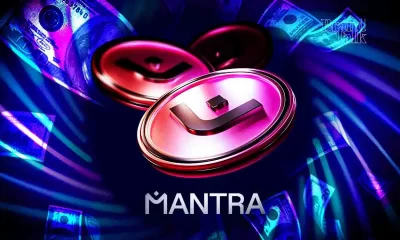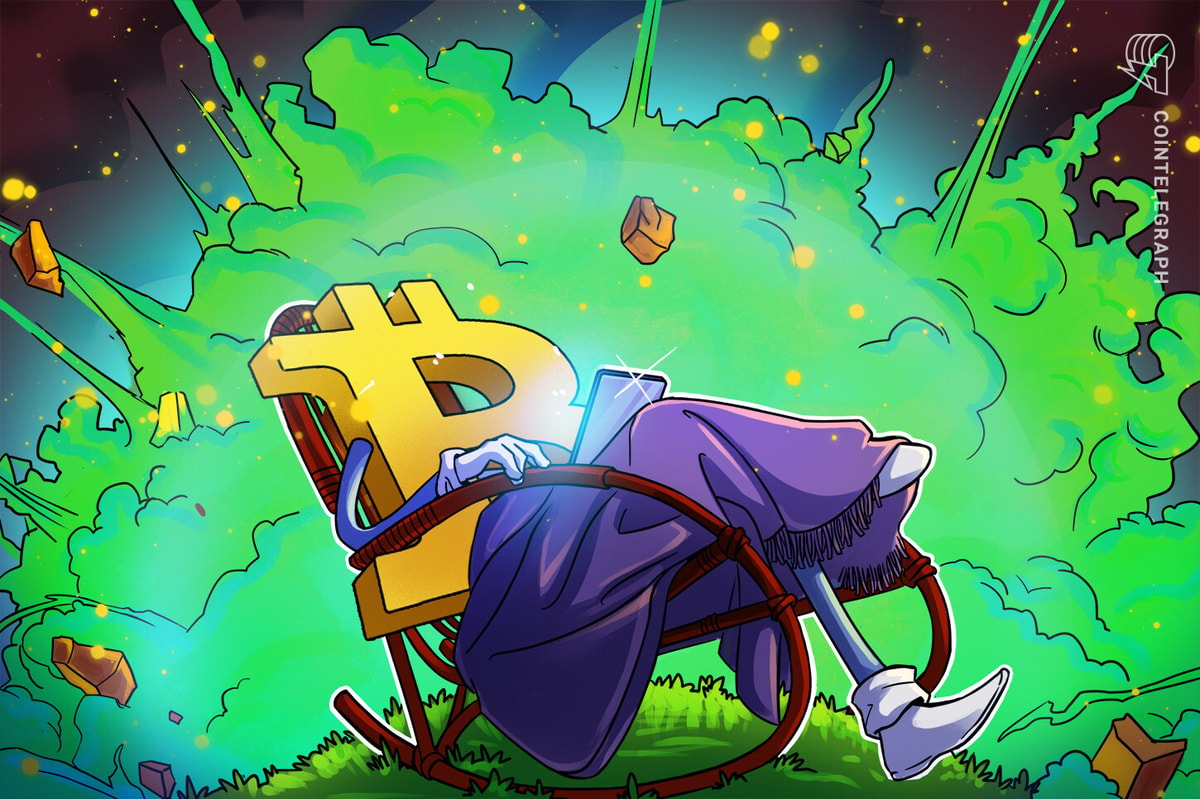Uncategorized
Sentient open-source AI search outperforms GPT-4o and Perplexity
Published
2 weeks agoon
By
admin
Sentient, an artificial intelligence development platform backed by Peter Thiel’s Founders Fund, has released an open-source AI search framework that it says outperforms leading closed-source competitors.
The company announced the public release of Open Deep Search (ODS) on April 2, describing it as a high-performance, developer-friendly alternative to platforms like Perplexity AI and OpenAI’s GPT-4o.
Sentient’s ODS aims to empower developers with open-source “Loyal AI” models, which Sentient says preserve the original intent of their developers.
The firm’s fingerprinting technology allows developers to protect intellectual property while maintaining model openness — aiming to solve the biggest issue of open-source AI, the challenges of monetizing a model without centralization.
“AI should belong to the community, not controlled by closed-source corporations,” according to Himanshu Tyagi, co-founder of Sentient and professor at the Indian Institute of Science.
“We’re building, monetizing and delivering open-source AI with a key principle in mind: singularity in intelligence but plurality in use cases,” he added.
”Open-source development ensures performance and user control that closed systems simply cannot match.”
Related: Crypto trader turns $2K PEPE into $43M, sells for $10M profit
Sentient’s ODS outperforms ChatGPT, Perplexity
Sentient’s ODS scored 75.3% accuracy on the “Frames” benchmark, which measures factuality, retrieval and reasoning capabilities, used to answer complex “multi-hop questions” that require the integration of multiple sources.
ODS surpassed OpenAI’s ChatGPT-4o Search Preview’s 50.5% and the Perplexity Sonar Reasoning Pro, which scored 44.4%.
To prevent potential bias, Sentient ensured that its researchers didn’t have access to the Frames testing sets during the benchmarking process.
Dobby NFT mint. Source: Sentient
“Independent verification is only needed for closed-source solutions because open-source solutions have no incentive to falsely report the evaluations,” Tyagi said, adding:
“Anyone with a computer can run our code, reproduce our results, and verify whether it is correct or not. The numbers reported can be reproduced using the repo’s eval section by anyone and thus are globally verifiable.”
The ODS release follows growing interest in Sentient’s platform. The firm said it amassed more than 1.8 million waitlist registrations in the lead-up to the launch.
Related: $1T stablecoin supply could drive next crypto rally — CoinFund’s Pakman
A turning point for open-source AI
The release of Sentient’s new open-source search framework comes amid a tipping point for open-source AI development.
“We’re witnessing a significant shift as open-source AI solutions increasingly challenge closed-source dominance,” Tyagi said.
“Examples such as DeepSeek’s advancements in reasoning, Manus’s innovations with agents, and now our own contributions to ODS with advanced AI search frameworks highlight this shift,” he added.
“Open-source models can easily outperform closed-source giants with the right architecture,” said Sewoong Oh, Sentient’s lead researcher and professor at the University of Washington. “The results of these benchmarks validate our mission to create an open ecosystem that benefits all AI builders and users.”
The launch also builds on Sentient’s earlier momentum. In February, the firm completed one of the largest NFT minting campaigns to date, with more than 650,000 participants gaining fractional ownership of its AI models.
Magazine: ‘Chernobyl’ needed to wake people to AI risks, Studio Ghibli memes: AI Eye
Mantra Team Responds As The OM Token Price Crashes Over 80% In 24 Hours This Week in Crypto Games: Gaming Tokens Crash Out, Eve Frontier Opens Up Commerce Secretary Lutnick walks back tariff relief on electronics Gold ETF Inflows Hit Three-Year High as PAXG, XAUT Outperform Wider Crypto Market Israel’s New Study Shows 51% Of Public Is Interested In Adopting CBDC (Digital Shekel) – Is That So? Solana Price Eyes Breakout Toward $143 As Inverse Head & Shoulders Pattern Takes Shape On 4-hour Chart Published on By Commerce Secretary Howard Lutnick walked back the recent reciprocal tariff exemption on select electronics announced in an April 12 bulletin from the United States Customs and Border Protection. On April 13, Lutnick told ABC News that the reciprocal tariff exemption was temporary until the administration established a sector tariff regime for semiconductor products, which includes phones, graphics processors, and computing chips in a “month or two.” Lutnick added: “President Trump has called out pharmaceuticals, semiconductors, and autos. He called them sector tariffs, and those are not available for negotiation. They are just going to be part of making sure we ensure core national security items are made in this country.” “We can’t be relying on China for fundamental things we need. Our medicines and our semiconductors need to be built in America,” Lutnick continued. The official also said he was confident that the US and China would arrive at a trade deal through negotiations. The emphasis on national security and onshoring critical industries could signal that the trade tariffs will be a long-term geostrategic policy and not simply a short-term negotiation tactic to make US exports more attractive, as some analysts have suggested. The Volatility S&P Index (VIX), a measure of the S&P stock index’s volatility, remains elevated amid macroeconomic uncertainty. Source: TradingView Related: Bitcoin ‘decouples,’ stocks lose $3.5T amid Trump tariff war and Fed warning of ‘higher inflation’ Trump’s trade tariffs crashed the stock and crypto markets, wiping away trillions in shareholder value as investors dumped riskier assets on fears of a lengthy trade war between the United States and its trading partners. In an April 10 X Post, Bloomberg analyst Eric Balchunas cited the SPY US Equity History Volume chart as evidence that the S&P 500 stock market index is now more volatile than Bitcoin (BTC). According to the analyst, the S&P 500 Index hit a volatility level of 74 in April, compared to Bitcoin’s 71. Stocks and crypto pumped following rumors of the Trump administration initiating a 90-day reciprocal tariff pause. Approximately $2 trillion was pumped into stocks on rumors of softer trade policies. Much of this value was then wiped away when Trump claimed that rumors of a 90-day pause were false and returned once the Trump administration did, in fact, issue a reciprocal tariff pause in the following days. Magazine: Financial nihilism in crypto is over — It’s time to dream big again Published on By Bitcoin (BTC) hit an eleven-day high on April 13 as the crypto market relief rally closely tracked US financial policy changes. BTC/USD 1-hour chart. Source: Cointelegraph/TradingView Data from Cointelegraph Markets Pro and TradingView showed BTC/USD reaching $86,000 for the first time since April 2. The pair had reacted well to news that US President Donald Trump had decided to exclude certain key products from his ongoing trade tariffs against China. Traditional markets are closed on weekends —creating lower-liquidity trading in crypto markets and raising the chance for price volatility— with Bitcoin subsequently dropping under $84,000. With hours to go until the weekly close, BTC/USD was thus up 7% for the week, having started with a trip to new five-month lows. Commenting, traders were cautious over BTC price strength. Call me crazy but I don’t think I trust this breakout on $BTC. Low volume, overbought stoch, and on a weekend. If we can remain over 84k through Monday I’ll look for higher but for now this seems sketchy. pic.twitter.com/qKVdYAOYPJ — Roman (@Roman_Trading) April 12, 2025 Daan Crypto Trades noted the ongoing interplay with the 200-day exponential moving average (EMA) at $85,000. “This is however still a weekend move so far and we know next week will be volatile again with news regarding tariffs and the first big tech earnings coming up,” part of a post on X read. BTC/USD 1-day chart with 200 EMA. Source: Cointelegraph/TradingView Well-known trader Peter described the rebound from the lows as looking “more corrective than it does impulsive.” BTC/USD 2-hour chart. Source: Peter Brandt/X Popular trader and analyst Rekt Capital meanwhile saw the true hurdle to a Bitcoin bull market rebound coming in the form of a stubborn long-term daily downtrend. “Bitcoin has Daily Closed above the Downtrend. Thus, breakout confirmation is underway,” one of his latest X updates explained alongside an illustrative chart. “However BTC has previously Daily Closed above the Downtrend but failed its retest (a few of the red circles). Retest needs to be successful and it is in progress.” BTC/USD 1-day chart. Source: Rekt Capital/X As Cointelegraph reported, the daily downtrend, in place since late 2024, is earmarked as a key hurdle for bulls to overcome. Related: Bollinger Bands creator says Bitcoin forming ‘classic’ floor near $80K Another post flagged promising signals on Bitcoin’s relative strength index (RSI) indicator. A classic leading indicator, RSI continued to print another bullish divergence with price on daily timeframes. “Bitcoin is developing yet another Higher Low on the RSI while forming Lower Lows on the price,” Rekt Capital summarized. “Overall, throughout the cycle Bitcoin has formed Bullish Divergences like this on a few occasions already. Each Bull Div preceded reversals to the upside.” BTC/USD 1-day chart with RSI data. Source: Rekt Capital/X This article does not contain investment advice or recommendations. Every investment and trading move involves risk, and readers should conduct their own research when making a decision. Published on By Crypto gaming and gambling campaigns are the most expensive way to acquire users with existing crypto wallets, ranking highest in cost among all sectors of the crypto industry, recent data shows. “Gaming and gambling campaigns are the most expensive, with a median CPW of $8.74 and a lower quartile of $3.40,” Web3 marketing firm Addressable co-founder Asaf Nadler said in a recent report posted on X. CPW, or cost per wallet, is deemed a higher “quality” metric because it tracks the cost of website visitors with a crypto wallet already installed in their browser. Nadler previously told Cointelegraph that their analysis data showed that users with a wallet are more likely to convert to crypto products. CPW across different regions during the bull markets in Q1 an Q4 of 2024. Source: Asaf Nadler Nadler said the high cost-to-return ratio of crypto gaming and gambling might be due to “higher churn, speculative behavior, and intense competition.” He added: “If Web3 gaming is truly “inevitable,” we need to find a more powerful UA engine to make it as sustainable as in Web2.” However, Axie Infinity co-founder Jeff “JiHo” Zirlin said in an April 11 post on X that periods of high CPW are a good time to experiment. “Create new games/product lines, consolidate our market share, and get ready for the next market expansion,” Zirlin said. “Know when it’s a coiling phase. Know when it’s time to explode,” he added. Meanwhile, decentralized finance (DeFi) and Centralized Finance (CeFi) campaigns have it a lot easier with attracting new crypto users. “DeFi/CeFi campaigns are the most cost-efficient, with a median CPW of $2.79 and a lower quartile of just $0.10,” Nadler said. The results are based on 200 programmatic campaigns run on Addressable by over 70 advertisers, claiming to target an estimated 9.5 million users globally. CPW results across various sectors of the crypto industry. Source: Asaf Nadler It tracks how CPW varies across market cycles, regions, campaign strategies, and audience segments. Nadler said that while premium markets experience low-cost conversions for existing crypto wallet holders during bull runs, attracting their attention becomes significantly more expensive during market downturns. Related: Trump kills DeFi broker rule in major crypto win: Finance Redefined He highlighted that in 2024, the US and Western Europe saw CPW increase by four times and 27 times, respectively, between Q1 and Q3, as the markets continued to consolidate and interest from crypto wallet holders waned. “While these markets provide scale and quality during bull runs, they become significantly more expensive when sentiment turns bearish, making them less sustainable during downturns,” Nadler said. Meanwhile, emerging markets like Latin America and Eastern Europe “offer exceptionally low CPW in favorable conditions but can experience extreme cost volatility.” Magazine: Bitcoin eyes $100K by June, Shaq to settle NFT lawsuit, and more: Hodler’s Digest, April 6 – 12 Arthur Hayes, Murad’s Prediction For Meme Coins, AI & DeFi Coins For 2025 Expert Sees Bitcoin Dipping To $50K While Bullish Signs Persist Aptos Leverages Chainlink To Enhance Scalability and Data Access Bitcoin Could Rally to $80,000 on the Eve of US Elections Crypto’s Big Trump Gamble Is Risky Sonic Now ‘Golden Standard’ of Layer-2s After Scaling Transactions to 16,000+ per Second, Says Andre Cronje Institutional Investors Go All In on Crypto as 57% Plan to Boost Allocations as Bull Run Heats Up, Sygnum Survey Reveals Ripple-SEC Case Ends, But These 3 Rivals Could Jump 500x
Source link You may like












Uncategorized
Commerce Secretary Lutnick walks back tariff relief on electronics

Trade war heightens volatility and sends markets tumbling
Source link Uncategorized
Bitcoin price tags $86K as Trump tariff relief boosts breakout odds

Bitcoin traders say brace for more volatility
RSI bullish divergence still in play
Source link Uncategorized
Crypto gaming and gambling ads ‘most expensive’ for onboarding users

“Higher churn” rate may be to blame
Premium markets cost more to reach crypto users during downturns
Source link 
Mantra Team Responds As The OM Token Price Crashes Over 80% In 24 Hours

This Week in Crypto Games: Gaming Tokens Crash Out, Eve Frontier Opens Up

Commerce Secretary Lutnick walks back tariff relief on electronics

Gold ETF Inflows Hit Three-Year High as PAXG, XAUT Outperform Wider Crypto Market

Israel’s New Study Shows 51% Of Public Is Interested In Adopting CBDC (Digital Shekel) – Is That So?

Solana Price Eyes Breakout Toward $143 As Inverse Head & Shoulders Pattern Takes Shape On 4-hour Chart

Crypto malware silently steals ETH, XRP, SOL from wallets

Binance Executives Met With US Government Officials To Discuss Easing of Regulatory Supervision: Report

Michael Saylor Hints At Another MicroStrategy Bitcoin Purchase, BTC Price To Rally?

From the Crypto Trenches to the Hill: Why Solana Is Making a Big Push in Washington

Bitcoin price tags $86K as Trump tariff relief boosts breakout odds

Where Top VCs Think Crypto x AI Is Headed Next

India’s Leading Bitcoin And Crypto Exchange Unocoin Integrates Lightning

Solana Triggers Long Thesis After Pushing Above $125 – Start Of A Bigger Rally?

Popcat price surges as exchange reserves fall, profit leaders hold

Arthur Hayes, Murad’s Prediction For Meme Coins, AI & DeFi Coins For 2025

Expert Sees Bitcoin Dipping To $50K While Bullish Signs Persist

Aptos Leverages Chainlink To Enhance Scalability and Data Access

Bitcoin Could Rally to $80,000 on the Eve of US Elections

Crypto’s Big Trump Gamble Is Risky

Sonic Now ‘Golden Standard’ of Layer-2s After Scaling Transactions to 16,000+ per Second, Says Andre Cronje

Institutional Investors Go All In on Crypto as 57% Plan to Boost Allocations as Bull Run Heats Up, Sygnum Survey Reveals

Ripple-SEC Case Ends, But These 3 Rivals Could Jump 500x

Has The Bitcoin Price Already Peaked?

A16z-backed Espresso announces mainnet launch of core product

The Future of Bitcoin: Scaling, Institutional Adoption, and Strategic Reserves with Rich Rines

3 Voting Polls Show Why Ripple’s XRP Price Could Hit $10 Soon

Xmas Altcoin Rally Insights by BNM Agent I

Blockchain groups challenge new broker reporting rule

I’m Grateful for Trump’s Embrace of Bitcoin
Trending


















